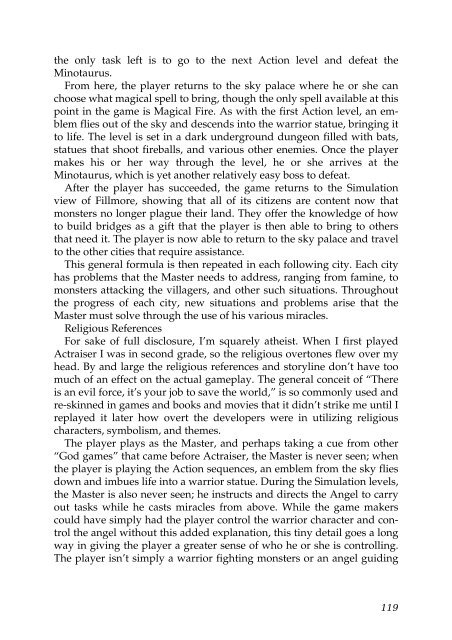Well Played 2.0: Video Games, Value and Meaning - OpenLibra
Well Played 2.0: Video Games, Value and Meaning - OpenLibra
Well Played 2.0: Video Games, Value and Meaning - OpenLibra
Create successful ePaper yourself
Turn your PDF publications into a flip-book with our unique Google optimized e-Paper software.
the only task left is to go to the next Action level <strong>and</strong> defeat the<br />
Minotaurus.<br />
From here, the player returns to the sky palace where he or she can<br />
choose what magical spell to bring, though the only spell available at this<br />
point in the game is Magical Fire. As with the first Action level, an emblem<br />
flies out of the sky <strong>and</strong> descends into the warrior statue, bringing it<br />
to life. The level is set in a dark underground dungeon filled with bats,<br />
statues that shoot fireballs, <strong>and</strong> various other enemies. Once the player<br />
makes his or her way through the level, he or she arrives at the<br />
Minotaurus, which is yet another relatively easy boss to defeat.<br />
After the player has succeeded, the game returns to the Simulation<br />
view of Fillmore, showing that all of its citizens are content now that<br />
monsters no longer plague their l<strong>and</strong>. They offer the knowledge of how<br />
to build bridges as a gift that the player is then able to bring to others<br />
that need it. The player is now able to return to the sky palace <strong>and</strong> travel<br />
to the other cities that require assistance.<br />
This general formula is then repeated in each following city. Each city<br />
has problems that the Master needs to address, ranging from famine, to<br />
monsters attacking the villagers, <strong>and</strong> other such situations. Throughout<br />
the progress of each city, new situations <strong>and</strong> problems arise that the<br />
Master must solve through the use of his various miracles.<br />
Religious References<br />
For sake of full disclosure, I’m squarely atheist. When I first played<br />
Actraiser I was in second grade, so the religious overtones flew over my<br />
head. By <strong>and</strong> large the religious references <strong>and</strong> storyline don’t have too<br />
much of an effect on the actual gameplay. The general conceit of “There<br />
is an evil force, it’s your job to save the world,” is so commonly used <strong>and</strong><br />
re-skinned in games <strong>and</strong> books <strong>and</strong> movies that it didn’t strike me until I<br />
replayed it later how overt the developers were in utilizing religious<br />
characters, symbolism, <strong>and</strong> themes.<br />
The player plays as the Master, <strong>and</strong> perhaps taking a cue from other<br />
“God games” that came before Actraiser, the Master is never seen; when<br />
the player is playing the Action sequences, an emblem from the sky flies<br />
down <strong>and</strong> imbues life into a warrior statue. During the Simulation levels,<br />
the Master is also never seen; he instructs <strong>and</strong> directs the Angel to carry<br />
out tasks while he casts miracles from above. While the game makers<br />
could have simply had the player control the warrior character <strong>and</strong> control<br />
the angel without this added explanation, this tiny detail goes a long<br />
way in giving the player a greater sense of who he or she is controlling.<br />
The player isn’t simply a warrior fighting monsters or an angel guiding<br />
119

















